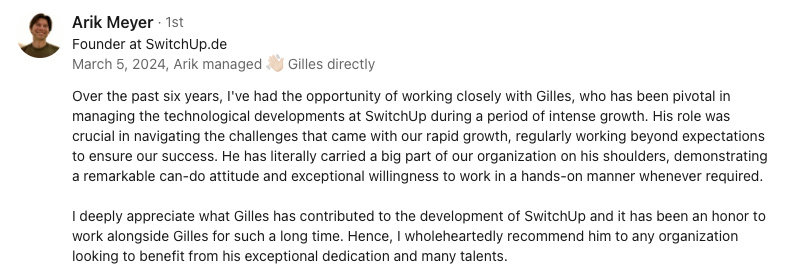Abstract:
The article explores the transformative potential of neuromorphic computing in the Internet of Things (IoT) landscape, emphasizing its ability to mimic the brain's neural architecture to enhance energy efficiency and processing speed. Traditional computing systems, often hindered by high power consumption and slow sequential processing, struggle to meet the demands of IoT devices that require quick, energy-efficient data handling. Neuromorphic computing offers a solution through its parallel processing capabilities, which significantly reduce power usage and latency, making it ideal for battery-powered IoT applications like smart city sensors and self-driving cars. The article highlights successful European case studies, such as SynSense's ultra-low-power hardware and Prophesee's vision systems, showcasing the practical benefits of this technology. For startups interested in integrating neuromorphic computing, strategic steps such as conducting pilot projects, leveraging partnerships with research institutions like the Human Brain Project and Fraunhofer Institutes, and securing funding through programs like Horizon Europe are recommended. The article also stresses the importance of understanding EU regulations like GDPR and NIS to ensure compliance in deploying neuromorphic IoT solutions. Overall, neuromorphic computing is presented as a promising innovation for developing sustainable, responsive IoT systems.
Have you ever considered how the brain's efficiency might revolutionize our tech world? Neuromorphic computing aims to do just that by mimicking the brain's architecture. With the rise of the Internet of Things (IoT), devices need to process data quickly while conserving energy. Traditional systems often fall short, consuming excessive power and taking too long. Neuromorphic computing offers a smarter, more sustainable solution, setting new standards for IoT and paving the way for innovation.
Exploring neuromorphic computing in IoT
Neuromorphic computing is making significant strides in the IoT field. By emulating the brain's neural architecture, it offers a fresh approach to data processing, tailored to IoT's needs for energy efficiency and speed. Traditional systems, despite advancements, often lag due to high power consumption and slow processing. In a project I worked on in Berlin, these limitations were evident. We required a scalable solution, but the hardware struggled with real-time data processing. Neuromorphic systems change the landscape by mimicking brain functions, enhancing IoT performance. Moreover, they provide a competitive edge in AI and machine learning applications by enabling more efficient pattern recognition and decision-making processes.
Overcoming IoT computing challenges
Traditional computing isn't always equipped to handle the demands of IoT edge devices. These devices need to process data instantly while using minimal energy. Neuromorphic systems are well-suited for this with their brain-like setup for quick, energy-efficient processing. Here's a quick comparison:
-
Traditional Systems:
- High power consumption
- Slower due to sequential processing
-
Neuromorphic Systems:
- Lower power usage with parallel processing
- Faster, akin to synaptic functions
This makes neuromorphic computing ideal for IoT, which often relies on battery power and rapid data analysis.
The need for energy efficiency and real-time processing
The IoT landscape is extensive, with many devices operating on batteries. Thus, energy efficiency is crucial. Neuromorphic chips significantly reduce energy consumption compared to standard processors. They can save substantial power, making them excellent for sustainable IoT operations.
Real-time processing is also vital for IoT, from self-driving cars to smart cities. These systems need to make swift decisions. Neuromorphic systems excel in this area, providing the necessary speed and intelligence. In self-driving cars, for example, quick data processing is critical. Neuromorphic computing is essential for addressing these complex tasks, making IoT solutions smarter and more responsive.
Advantages of neuromorphic systems in IoT edge applications
Reducing latency and power consumption
Neuromorphic chips are transforming IoT edge applications by processing data locally and reducing the need to send data to central servers. This minimizes latency and allows devices to react in real-time, similar to how our brains quickly respond to stimuli. The chips' event-driven nature means they process data only when necessary, reducing delays and enhancing performance. This setup is ideal for modern IoT systems, offering an advantage over traditional methods.
Their event-driven design also conserves power. Devices remain inactive until needed, saving energy. This is beneficial for battery-powered IoT devices like sensors. Consider a smart city sensor that activates only when there's movement or noise, conserving battery life. This power management aligns with IoT needs, ensuring long-lasting and sustainable operations.
European case studies
In Europe, companies are at the forefront of using neuromorphic computing for IoT with notable success. SynSense develops ultra-low-power neuromorphic hardware for smart sensors that process data in real-time, reducing latency and energy consumption. Their technology is crucial for fast-response applications like health monitoring wearables.
Another pioneer is Prophesee, known for neuromorphic vision systems inspired by the human eye and brain. They excel in smart surveillance and automotive safety, capturing only scene changes to conserve data and power. This enhances safety in vehicles and opens new opportunities for smart cities. These European innovations underscore the immense potential of neuromorphic computing in IoT, inspiring others in the field. Beyond IoT, neuromorphic computing could also revolutionize industries like healthcare and finance by enhancing cybersecurity through advanced pattern recognition and anomaly detection.
Strategic integration for startups
Integrating neuromorphic computing into IoT setups can seem daunting for startups in a competitive market. However, with a clear plan, it can be achieved effectively. Here's how startups can approach this.
Integration steps
Assess Current Setup: Evaluate your existing IoT setup to determine compatibility with neuromorphic systems. Investigate platforms like Intel's Loihi for neuromorphic tasks. Create a checklist to assess readiness, focusing on hardware and software needs.
Pilot Project: Develop a pilot project to test neuromorphic integration on a small scale before full implementation. During this pilot, measure improvements in performance and energy efficiency to decide if the benefits are worthwhile.
Design a Test Case: Design a test case to demonstrate how your system will function in real life. This approach helps identify issues before full deployment.
Partner with Experts: Collaborate with experts and research institutions for valuable insights and support. Engaging with groups like the Fraunhofer Institutes or the Human Brain Project provides access to the latest research and solutions.
Addressing challenges
Integrating neuromorphic systems into IoT setups can present challenges, particularly with complexity and cost. Startups can overcome these by utilizing open-source tools and forming partnerships to share knowledge and resources. These tools reduce costs and make technology more accessible, allowing startups to focus on innovation.
Scalability is another concern, but a modular design can help. By structuring systems modularly, you ensure they grow with your IoT needs. Picture them as building blocks, expandable with new demands, keeping you adaptable.
This approach not only addresses current challenges but also sets the stage for future innovation. Collaboration is crucial, leading to solutions that resolve today's problems and pave the way for breakthroughs. Taking these steps helps startups integrate advanced technology and lead in IoT innovation.
Collaborative partnerships
Innovation in neuromorphic computing and IoT thrives on effective partnerships. The Human Brain Project offers excellent opportunities for collaboration with leading researchers. It supports startups exploring neuromorphic tech. The Fraunhofer Institutes also play a significant role, offering joint projects that boost innovation. These partnerships provide access to cutting-edge research and a network for accelerated progress.
- Human Brain Project: humanbrainproject.eu
- Fraunhofer Institutes: iis.fraunhofer.de
Fraunhofer Institutes focus on practical research, bridging theory and practice. Partnering with them accelerates the development of innovative neuromorphic IoT solutions. Besides resources, these collaborations offer valuable networks, paving the way for significant advancements.
Funding sources
Securing the right funding transforms promising projects into successes. Horizon Europe is a key funding source for digital and emerging tech projects, including neuromorphic computing. It supports innovations that push boundaries, providing financial backing for exploring and developing cutting-edge tech. Clear project goals and innovation are essential for securing funding.
The European Innovation Council is another important source. Its EIC Accelerator program supports high-risk, high-potential innovations, like those in neuromorphic computing. It fuels transformative ideas with the potential to redefine industries. Although the application process is challenging, it offers a platform for ambitious ideas, with the chance for significant funding. Engaging with these programs opens financial opportunities and connects startups with innovators and researchers, boosting their journey to groundbreaking achievements.
Understanding EU compliance for neuromorphic IoT
Navigating the European regulatory landscape is essential for deploying neuromorphic IoT applications. Understanding the key regulations and standards helps ensure compliance and reduce legal risks.
EU regulations overview
For IoT devices handling personal data in Europe, the General Data Protection Regulation (GDPR) is crucial. It requires lawful, secure, and transparent data processing. If your device collects personal data, you need user consent and must inform them about data usage. GDPR gives users control over their data, allowing access and deletion requests. This is vital as neuromorphic IoT devices often handle sensitive data.
The Network and Information Security (NIS) Directive is another important regulation. It enhances cybersecurity across the EU, requiring essential service operators and digital providers to have robust security measures and report cyber incidents. For IoT operators, this means securing infrastructure against threats and having procedures for quick breach responses.
Strategies for compliance
Startups in the neuromorphic IoT space can benefit from engaging with regulatory bodies and industry associations. The IoT European Large-Scale Pilots Programme offers guidance on regulatory changes and a platform for discussing challenges and solutions. Staying informed helps startups anticipate regulatory shifts and adapt to stay compliant.
Implementing strong data encryption and cybersecurity measures is also key. Securing data at rest and in transit protects sensitive information and aligns with GDPR and NIS requirements. Here's a simple checklist for startups:
- Encrypt all personal data to prevent unauthorized access.
- Regularly update security protocols against new vulnerabilities.
- Have and test incident response plans for quick recovery from breaches.
Adopting these strategies mitigates risks and allows startups to focus on innovation, ensuring their neuromorphic IoT solutions meet current and future regulatory demands.
Neuromorphic computing is a beacon of innovation in IoT, mirroring the brain's remarkable efficiency. It reduces power use and latency, paving a sustainable path for IoT, from smart cities to self-driving cars. Imagine IoT devices reacting instantly and using minimal energy—this is the promise of neuromorphic systems. As this technology evolves, startups and innovators have the opportunity to push boundaries, creating powerful and eco-friendly IoT solutions. How do you think neuromorphic computing will shape the IoT world? Share your thoughts!
You might be interested by these articles:
- Optimizing Neural Network Training with Neuromorphic Computing Systems
- Neuromorphic Computing Trends
- Advancing AI with Neuromorphic Computing
See also:
- Gilles Crofils: Skills, Industries and Markets
- Leveraging Technology for Food Stability
- Smart Tech Revolutionizes Urban Water Management
- Enhancing Disaster Resilience for Vulnerable European Communities
- Turning Compliance Challenges into Growth Opportunities for AI Startups in the EU
- The Impact of Quantum Computing on Cybersecurity Strategies
- Turning tech puzzles into progress with C++ in Europe





